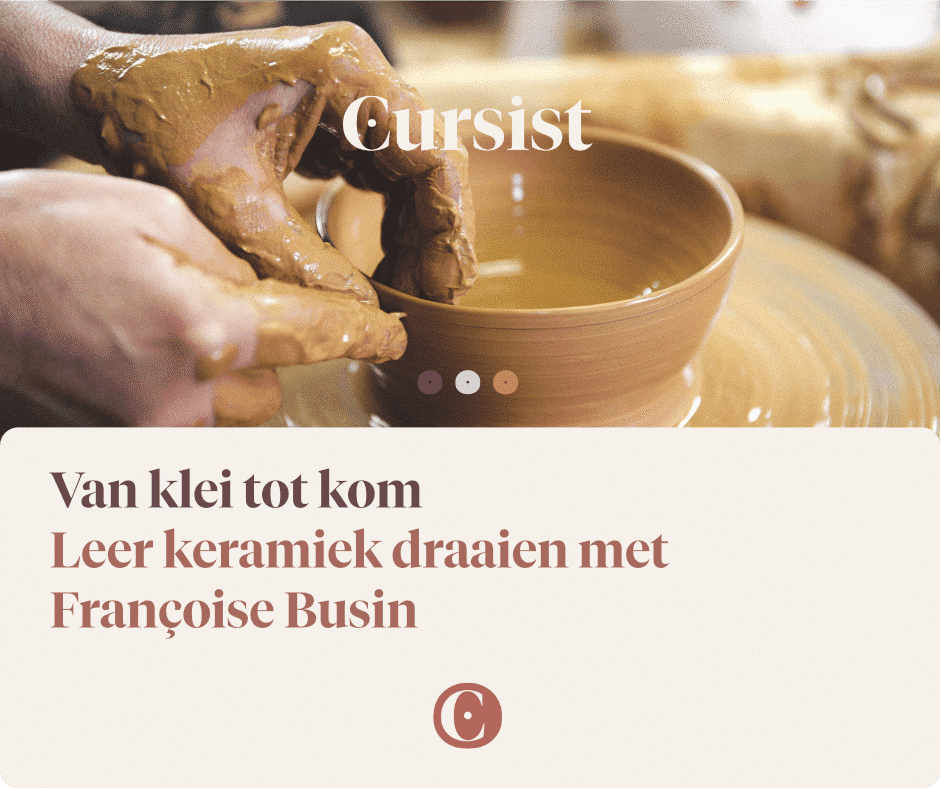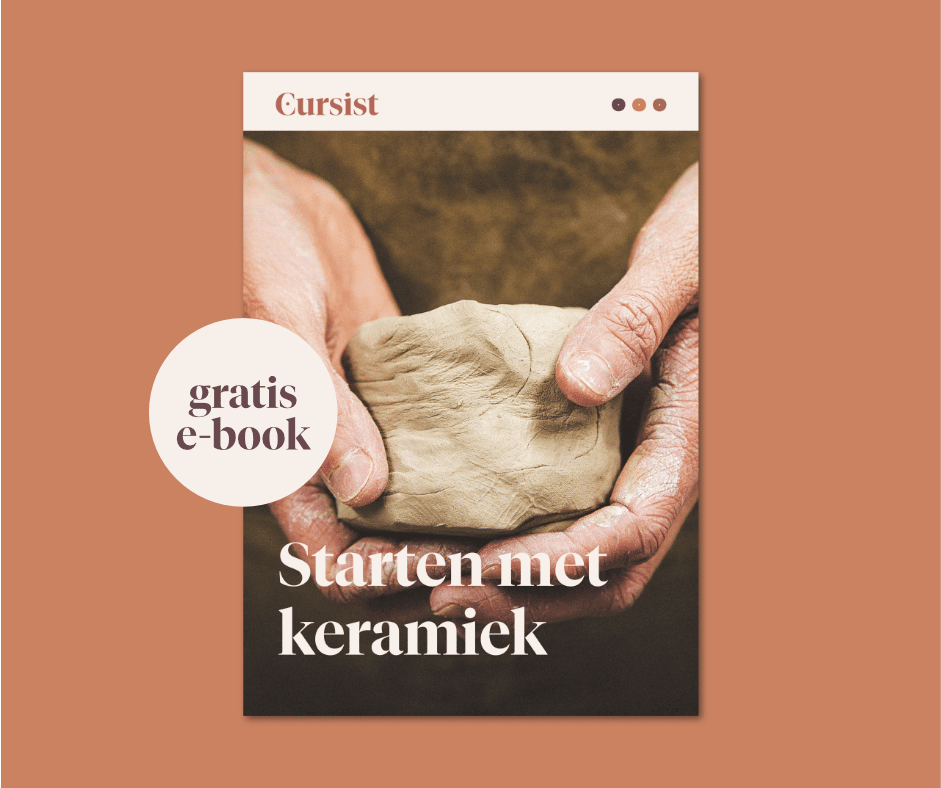Want to start drinking your daily coffee from a unique mug you’ve made with your own two hands? Want to arrange freshly picked flowers in a special vase that you created from scratch? Want to fill your sunny terrace with bright flower pots that have exactly the colour and decorations that you wanted? Want to serve a lovely salad in a home-made bowl at your next summer barbecue?
All of these scenarios make my heart beat faster. Because anything to do with clay, ceramics and pottery, genuinely makes me happy. It’s a passion I love to share, through the Cursist. Because maybe pottery and you is also a match made in heaven.


Want to give it a try? Check out our pottery overview below. Or jump off the deep end and sign upfor one of our online video courses.
Have fun on your pottery journey!
Pottery: is it for you?
You like working with your hands
Getting the clay all over your hands, feeling its texture between your fingers, kneading it, pulling it up on the pottery wheel… You can feel the creative ideas flow from your head through your shoulders straight to your fingers. And that excites you: making something by yourself, improving your technique and letting your imagination run free.
You’re interested in meditation
I often say that making ceramics and pottery is a form of meditation. When you’re making pottery all of your attention is completely focused on the clay, your movements, the technique, the shape you want to create … In other words: you’re completely in the zone. This has many benefits, which you can read about in the article“Pottery, a form of meditation”.
You’re looking for peace and fulfillment
Making pottery is peaceful. The meditative and creative aspects make a very powerful combination. One that brings a feeling of fulfillment. No matter whether your latest creation is a success or a failure. The clay is quick to forgive.
You know that failure equals learning
When you’re first starting to learn pottery, you should expect to create a bunch of failed pots, or at least ones that have some funky shapes. And that’s a good thing, because trial and error is essential when it comes to pottery. Every time you fail, you learn. And every potter knows what to do in that moment: you take a deep breath, and you simply try again. Failure gives you the opportunity to grow and continue to improve your creations. And your failed pots? Those end up as recylced clay!
How do you get started with pottery?
Apart from eager hands and a passion for creating, you also need a few supplies and materials to get started with pottery. Below you’ll find a helpful list.
Clay
It all starts with clay. After all, pottery is nothing more than clay that has been fired. But before it goes into the oven, you knead and shape it to create a specific form. And not every type of clay is suitable for every form and technique. The first time you enter a pottery shop, you might end up overwhelmed by all of the different types of clay you can choose from.
You choose the right clay by looking at its specific properties: Plasticity, strength, water absorption, texture.
Based on these properties, clay is divided into three categories: Earthenware, stoneware, and porcelain.
As a beginner, make sure you choose a clay that is plastic and slow to absorb water. What type of strength and texture you need, depends on the size of the project you’re working on. Beginners are better off working with stoneware. It’s quite strong and plastic, but it also holds its shape quite well.

The label should tell you everything you need to know about the clay. Once you check the label, you’ll have a good idea of whether the properties of this clay match the project you have in mind. In the article “choosing clay for beginners” you can learn even more about the different types of clay available in the pottery store.
Supplies you already have at home
If you plan to make pottery at home, gather the following supplies:
- Bucket: With a full bucket by your side you can add water to the clay when needed.
- Sponge: With a sponge you can remove excess water.
- Wooden board with no coating: When you knead clay, you need to do it on a surface that absorbs moisture. A wooden table or board that does not have a coating is perfect for that.
- Scissors: To get that new bag of clay opened up, you’ll need a pair of scissors.
- Old bank card: When you’re shaping your clay, a flat, thin card often comes in handy.
- Ruler: Essential to measure your pots, which is especially useful if you’re making a set.
- Metal spatula: A great tool to easily get your pot off of the pottery wheel.
- Kitchen scale: Make sure to weigh the clay you’re working with, it’s important to use the right amount.
- Cling film or plastic bags: To slow down the drying process, you can wrap your pots (partly) in plastic. This ensures the clay will take longer to dry.
- Old towel: A towel is great to wipe the clay off your hands.

Supplies you need to buy in the pottery shop
You probably don’t have these supplies lying around at home but you can find them in a pottery store. You can find the store nearest to you on this handy map.
- Cut-off wire: A cut-off wire is used to cut a piece of clay from the pack or to get your pot off the pottery wheel.
- Pin tool: A pin tool helps you check the bottom of your pot, correct the rim of your pot while throwing or add decorations.
- Metal or wooden trimming tool:When you’re ready to trim your work and clean the base of your pot, a tool like this comes in handy.
- Ribbon tool(s): these are useful for many techniques. Especially when trimming they are very useful.
- Metal rib: A great help to create smooth curves.
- Calipers: A tool that can tell you at a glance whether your bowls or plates are the same size.
- Glaze:As a beginner it’s a good idea to choose a ready-to-use glaze. Glazing is an art in itself, which the Cursist has already devoted two courses to: Discover the world of glazing part 1 and Discover the world of glazing part 2.
- Glazing brush: There are many different ways to apply glaze, but a glazing brush is a great option for beginners.
Want to know more about the supplies every potter should have in their studio? Read this article on pottery supplies.
You'll also need these
A pottery wheel
Even though you can absolutely make pottery without a wheel – by sculpting for example – you do of course need one if you want to learn wheel throwing. There are a lot of different pottery wheels on the market. Which one is right for you, depends on personal preference. So choose one that’s a good match for you.
Well-known brands such as Shimpo, Roderveld, Brent or Rohde make pottery wheels of good quality. A decent one can easily cost €1000. If you go for something cheaper, you end up with inferior quality. Some pottery stores let you rent or test out pottery wheels before you buy. That way you can make sure you’ve found the right match before you make the purchase.
There are electric pottery wheels, kick wheels, tabletop wheels … Can’t see the wood for the trees? Read this article on” making pottery with a pottery wheel“.
A kiln
A kiln for pottery is nothing like the oven in your kitchen. Because firing clay requires temperatures of over 1000°C. And that requires a kiln. There are electric kilns, wood kilns and gas kilns.
Wood kilns and gas kilns have a flame that you can use for reduction firing. This enables you to have glazes that contain iron or copper to oxidise and change colour. You can’t really do this with an electric kiln, or at least not easily.
Most potters have their pots fired in a pottery studio, so they don’t have a kiln at home. This is because kilns are very expensive. If you do want to buy an kiln, you need to make sure you have the right power connection for the types of pottery you want to fire. Porcelain for example requires a higher firing temperature than stoneware.
If you’re looking for a place to have your pots fired, be sure to browse this map of pottery studios.

A good beginner’s course
Yes, there are many YouTube videos and blog posts you can learn from. But to really master pottery you’ll need to invest in a good pottery course. There are several studios that offer beginner courses. The Cursist offers many different online video courses. The beginner’s course is ‘From clay to pot‘.
An experienced instructor
To be a good pottery instructor, you don’t just need to be good at pottery. You also need to be able to convey your knowledge. Even if someone is good at pottery, that doesn’t they are also good at teaching. The instructors that teach Cursist courses are not only talented potters and ceramists with tons of experience and expertise, they are also great teachers.
One of those teachers, for example, is Françoise Busin. She is the instructor for the beginner’s course From clay to pot. According to Françoise, you can’t fail if you follow the right steps attentively, if you practice a lot and, above all, if you enjoy the clay. “Everyone can do it, except the people who quit before they succeed.”
The benefits of an online pottery course
Learning pottery online? Yes you can! The Cursist offers courses for every level: from beginner to advanced. And our online courses come with a lot of benefits:
You do the video course whenever you want, at your convenience.
Has something come up? Simply pause the video and your instructor will wait patiently until you have time to continue the lesson. Do you have a lot of time right now? Then you can binge several lessons in a row. That’s how flexible it is! And you have lifetime access to the full course.
The video lessons focus on the teachers’ hands.
Showing you clearly how they do it. Want to see it again? Simply rewind the video. Want to see their movements slowed down? You can! Just reduce the playback speed. You’re always in the front row.
The online courses have a clear structure.
Each course is set up according to a clear logic. They start with the basic knowledge and movements and end with a finished project. Each course is tailored to a specifc skill level. You can read more about that on the individual course pages.
You’ll get online support.
Some of the courses have a closed Facebook group where you can ask all your questions. Other courses have live online Q&A sessions at regular intervals, where your questions will be answered. Whether it’s in a Facebook group or during a webinar, you can show your work, ask for feedback and ask any questions you have about what you’ve learned in the course. So if you happen to get stuck, you’ll have the help you need to get back on track.

Ready to start your pottery journey?
Now that you have all of the basic information, it’s a lot easier to start making your own pottery.
Are you ready for the next step?
Check out our beginner’s course From clay to pot
A complete course on wheel throwing for beginners.
Download the beginner’s guide
All of your questions about pottery answered







